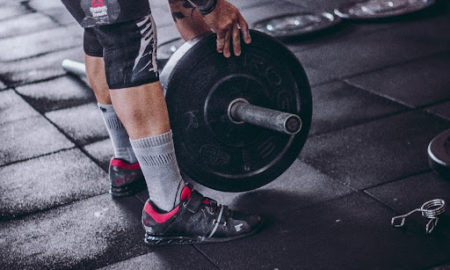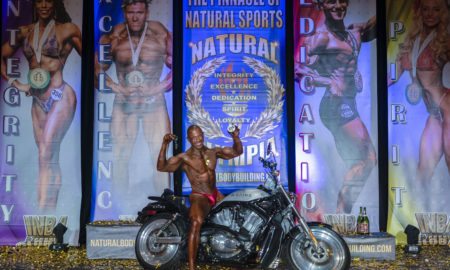Every so often a physique comes along that makes you pause, nod and say, “Wow, that’s exactly how I’d like to look.” Not big and freaky like most pros but an attainable look with excellent proportions and an athletic edge—a physique that has gals raising eyebrows rather than chuckling as it waddles by. Australian bodybuilder David Rylah has one of those bodies. He looks like he’d be good at beach volleyball or surfing as well a hitting poses in a bodybuilding show.
To top it off, his training is high intensity in the Mike Mentzer Heavy Duty, Dorian Yates Blood and Guts style—one or two all-out heavy sets per exercise with lots of forced reps and drop sets. Watching his training DVD, “Bodies Made Easy,” I was thoroughly impressed by the amount of muscle Rylah has built while performing only about four sets per bodypart.
Don’t misinterpret that as “easy training,” despite the title of his DVD. His training is brutal but quick. “Australian Muscle Machine” might have been a better title, as he grinds out the heavy reps like a well-oiled industrial-strength forklift.
And, yes, he has competed and done quite well. He won the light-heavyweight class at the ’00 IFBB Gold Coast and the ’02 IFBB Queensland. David is 5’11” and weighs around 220 pounds. He’s 35 years old and is a personal trainer.
So those are the basics on David Rylah. Let’s get to some training specifics.
IM: Have you always trained using a high-intensity style—from the very beginning?
DR: When I first started training, it was 1988 and Lee Haney was Mr. Olympia. Back then the typical style of training was a six-day split, working each bodypart twice per week with three to four exercises per bodypart and three to four sets per exercise—but the sets weren’t blood-and-guts style, so you inevitably saved yourself for the sets to come, whether it was consciously or subconsciously. I trained like that for about four years and then Dorian Yates came on the scene.
I loved the idea of his style of training. Training to absolute max had been how I’d trained for all other sports I’d been involved in. Driving myself to my absolute physical limits is what has always made it fun, challenging and rewarding for me, so when I saw how Dorian trained to build his amazing physique, I knew it was for me. I have trained like that ever since and see no reason to change. If it ain’t broke, don’t fix it!
IM: You usually do at least three progressively heavier warmup sets for the big exercises. What’s your philosophy on warmups, and why is it necessary to do that many?
DR: I do three warmup sets on the first exercise for each bodypart, but I usually don’t do more warmups for the following exercises unless they are quite different, like bent-over rows followed by chins. The warmup sets are just that. I want to make sure the muscle, connective tissue, joint and motor neurons are all warmed up and firing efficiently but without causing any fatigue so that when I do my one all-out set, everything is ready to go but is still totally fresh to smash the set that counts.
IM: On most of the upper-body work sets shown on your DVD, you do only five reps plus a few forced reps. Why not work in some higher-rep sets?
DR: Through experience I have found that lower reps work great for the upper body. I will up the reps for back and certain shoulder exercises, but in general the reps are low for upper body.
IM: I notice that on some work sets your forced reps are so slow that they force the time under tension to shoot up to 45 seconds or more for the set. Is that intentional? Do you believe forced reps should be done more slowly than regular reps?
DR: I’ve never actually timed them; I just make it as intense as possible by getting just enough spot to keep the weight moving but make sure my muscles have to work at their absolute max to complete the rep. I guess I do think forced reps should be slower than regular reps—except the reps that are close to failure—because that way you are sure you’re getting just enough spot to get the weight up rather than too much spot. That only takes away from the intensity. And, by the way, if a muscle isn’t sore for two or three days after I train it, I know I didn’t work hard enough.
IM: Speaking of soreness, Mike Mentzer often prescribed pure-negative sets. Do you ever use those or any other intensity tactics besides forced reps?
DR: Not that often but, yes, I do. I actually make sure every rep from the beginning of the set has the negative emphasized. So it’s always slow on the negative for me and powerful contractions on the positive. I find this produces much more intensity and is more enjoyable.
IM: A lot of bodybuilders use a different workout every time they train a bodypart. How often do you change exercises, or do you stick with the same basic routine most of the time?
DR: This is where my philosophy is very different. I don’t believe in changing up my exercises just for the sake of it. It doesn’t make sense to me to swap an exercise that works extremely well for me for an exercise that is so-so just for change.
People say we need to trick our muscles. Since when did our muscles develop brains? Our muscles only know intensity. If a workout is superintense and our muscles can’t cope with it, they have to adapt. So, if you hit a plateau, just train harder rather than swapping for some shitty exercise.
IM: You have great quads, but on the DVD you train them with only leg presses, squats and walking lunges, in that order, for one work set each. Why don’t you do leg extensions?
DR: I had knee injuries years ago from playing rugby, so I need to be careful with them. Leg extensions can cause damage to the cartilage behind the knee, so I mostly avoid them and stick to the compound movements. Just smash them with everything I’ve got. I do see lots of people doing leg extensions with no problems, but I’m playing it safe.
IM: I noticed that on close-grip pulldowns you did end-of-set partials, or X Reps. Do you ever use them on other exercises instead of forced reps?
DR: I use them on a few exercises. If there’s no one around to spot me, I might just keep going with partials till I can barely move the weight and the target muscles are fried and screaming with pain. Feels good!
IM: If you feel you need some specialization on a bodypart, how do you go about it—more sets, different exercises or what?
DR: If I feel I need to bring up a specific bodypart, I’ll create a workout day just for that bodypart so it gets all the attention. For example, if I feel I need to bring up my biceps, I’ll train just biceps on Wednesday. That way they get all the energy for that workout and all the postworkout nutrients; it’s not shared with another muscle group.
IM: Your style of training takes a toll on the body, so supplements must be important. What are your key ones?
DR: There are a few. [Laughs] Glutamine is the most important to me. I also use protein powders, multodextrin, creatine, arginine alpha ketoglutarate, acetyl L-carnitine, a fat burner, Q10, fish oil, probiotics, vitamin C and a multivitamin. I try to get my body in as close-to-perfect working order as possible
IM: Can you outline a typical day’s diet?
DR: Sure:
Upon waking: Glutamine, arginine alpha ketogluterate, acetyl L-carnitine, Q10 and a fat burner or strong coffee
Power walk: 45 minutes
Breakfast: 8 eggs (including 2 yolks) and oats or 2-4 slices whole-grain toast
Midmorning: Protein drink
Lunch: Chicken, rice and veggies
Midafternoon: Steak, rice and veggies
Preworkout (60 minutes before training): Protein drink with creatine and 40-60 grams medium-release carbs added
Preworkout (30 minutes before training): Fat burner or strong coffee
Immediately before training: Glutamine, arginine alpha ketoglutarate and acetyl L-carnitine
Immediately after training: Protein drink with 50 grams fast-release carbs, 50 grams medium-release carbs, creatine and glutamine
Dinner: Fish and salad or veggies
Before bed: Glutamine and arginine alpha ketoglutarate
IM: Does your training change at all during the winter, and do you bulk up to add muscle?
DR: My training is exactly the same both off-season and precontest—hard, heavy and intense. I can’t train any other way. I do add 10 to 12 pounds in the off-season, but that’s about it. I don’t believe in bulking up, as you only have to diet it off again come competition or photo shoot time and risk losing muscle. Plus, when you’re close to peak shape, it’s easy to see if any bodyparts are lagging or your shape isn’t coming together right. If you’re covered with 30 pounds or more of fat, you can’t see that until you’re close to your contest, and then it’s probably too late. Plus, I don’t think it’s healthy.
IM: Do you make a conscious effort to keep your physique athletic looking as opposed to freaky massive?
DR: Oh, yeah, always. I hate the big, bloated-looking physiques. I always try to keep my waist small and tight. The more athletic physiques always impress me over the sheer mass, and being a trainer, I speak with average people all the time. The general public feels the same way even though their perception of what’s freaky is way different from people in the bodybuilding industry. [Laughs]
IM: What are your future projects and goals?
DR: Right now I’m a trainer at one of the biggest gyms on the Gold Coast—7,000 members—and that’s keeping me very busy, probably too busy. On top of that I’ve got my training DVD that is selling well, and I also run an online personal-training business at www.diggfit.com. So I’m struggling to find time to focus on future projects, but I plan on making more DVDs, the next one being aimed at women, doing more books, getting into motivational speaking and possibly opening a gym in Sydney with a business partner down the track. I think that’s it for now!
IM: Whew! That’s quite a full plate. Thanks, David.
Editor’s note: To get a copy of David Rylah’s double-disc DVD “Bodies Made Easy,” visit www.Home-Gym.com or call 1 (800) 447-0008. His Web site is www.DavidRylah.com. IM
David Rylah’s Sample HIT Bodypart Workouts Chest
Low-incline bench presses
Warmup 2 x 12, 8
Warmup (incline flyes) 1 x 15
Work set 1 x 4 + 3 forced
Low-incline dumbbell presses 1 x 4 + 3 forced
Low-incline flyes 1 x 5 + 3 forced
Cable crossovers (drop) 1 x 8(4)Delts
Smith-machine behind-the-neck presses
Warmup 3 x 15, 10, 6
Work set (drop) 1 x 4 + 3 forced (3 + 2 forced)
One-arm lateral raises
Warmup 2 x 15, 10
Work set 1 x 10 + 5 cheats
One-arm cable laterals 1 x 10 + 5 cheats
Behind-the-back one-arm cable laterals 1 x 10 + 5 cheats
















You must be logged in to post a comment Login